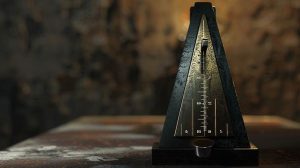
Should you know the chord changes?
I’ve always believed that the best way to gain skill as a musician is to develop one’s ear and its connection to the instrument. That belief led to the creation
Categories:
Categories:
Tuning technologies are very popular especially since hundreds are available on your phone for free. Google returns 34 million results for the search, “music tuning apps.” One ad actually read, “iOS or Android, we have an app for piano tuning that will make you the next Lang Lang, Beethoven, or perhaps Frederic Chopin.” I had no idea that a tuner app had that much superpower!
Putting aside the hype, this technology is obviously very popular, but is it useful for musicians?
Look at the three screens below from a tuning app. The needle straight up 12:00 designates an in tune note. If the needle moves to the left, the app thinks the note is flat. Needle on the right side designates the note is sharp.
The app shows us that notes two and three are out of tune.

How do you know if the intonation for these concert Cs is good or not? The needle tells you so, right? After all, your eyes don’t lie.
Or do they?
What does your ear tell you? Listen to the following three recordings of the above three concert C’s and confirm that only the C played on the left is in tune, as the app measures.
They all sound right even though they are slightly different pitches. So what’s going on?
I’m recording these notes within the context of various key centers. The first C is played over C major. The second C is the major third played over Ab major, and the third is the major 6th played over Eb major. In pure intonation (“just intonation”) the adjustments needed to play these pure intervals are to make the major third a bit flat and the major sixth a bit sharp.
Now, if you are playing with a piano, these adjustments are not entirely accurate or even practical, but in vocal choir or instrumental group without a piano, they sound beautiful. Pianos are tuned more or less with the intervals equal distance from each other.
The point of all this is to prove to you that intonation is contextual, with or without a piano, organ, or synthesizer. Your pitch depends on the harmony within which you are playing.
The fatal flaw of the tuning apps and other tuning robots is that they measure pitch as an absolute, when in fact, as I said earlier, pitch is contextual. This is the reason behind all that listening and playing I was encouraging you to do in the prior post.
I cringe whenever I see players behind stage or in the green room blowing long tones into their phone’s tuning app in order to get “in tune” for the gig. Even if that helps them move their tuning slide or mouthpiece closer to A-440 for that note at that moment in time, it does not assure them that they will play in tune once the music starts.
The problem with tuning machines and apps is that they treat intonation as an absolute. But good intonation is contextual, meaning that concert C over C major could be a slightly different frequency than C played over F#7.
Without a musical context, the mindset that tuning technologies breed is that intonation is an absolute. If you believe that you can set your instrument’s tuning to the app, you are likely not to hear the actual pitch of each note you play.
If you use a tuning app, have you noticed your tendency to find the “accurate” pitch? We want to be right so we chase the dial for the accurate frequency. Over half the surface of your brain is dedicated to vision while only 3% of your brain’s neurons are dedicated to hearing. So seeing the meter register that you’re flat is likely to be more persuasive than whatever your ear may be signaling to you.
I think the visual satisfaction provided by tuning app is a big part of its appeal.
I can hear you thinking that the technology is at least useful for getting your guitar tuned or for auditioning a new instrument. Trombone players will defend tuning apps for evaluating the pitch of the overtones throughout the seven positions. Some piano tuners will consider it useful for tuning. But all of those so-called benefits of a tuning app have a major downside. They take your focus away from what you hear.
The point of the previous post on intonation was to demonstrate the musical differences between notes within various contexts. It was also meant to expand your ears to some deeper implications of pitch. You are a musician, not a painter. Strengthen your ear so that you can use it and trust it.
Yes, delete your tuning app(s) and donate your vintage strobe tuner to Good Will. If you want to test out the intonation of a new instrument, play a drone tone rich in harmonics (or a simple sine wave if you hear that better) and play the instrument objectively without trying to find the in-tune pitch.
In the next post, I will talk about pitch used as a musical color.

Trombonist, author, marketer, & tech guy
Share this post…

I’ve always believed that the best way to gain skill as a musician is to develop one’s ear and its connection to the instrument. That belief led to the creation

I recently watched a video performance by the amazing classical pianist Yuja Chang. I’ve seen her memorizing motion and heard her virtuosic playing before, but something hit me after seeing

I have created a AI chatbot called Jazz Master Chat that draws from 75 hours of interviews from my Jazz Master Summit event a couple of years ago. I interviewed

My recently turned 18-year old son is a passionate photographer. He’s got himself a little business where people pay

A couple weeks ago I sent Richie Beirach a YouTube clip from the movie Whiplash as a bit of

I originally meant to write this as a reply to a comment Richie Beirach wrote on my blog. But

Tools for helping musicians at all levels learn about jazz and play to their full capability.
Web design and marketing by:
Michael Lake @JazzDigitalMarketing.com
This is just a fake book example for the type of website I can build for you. Just trying to use a little humor here!